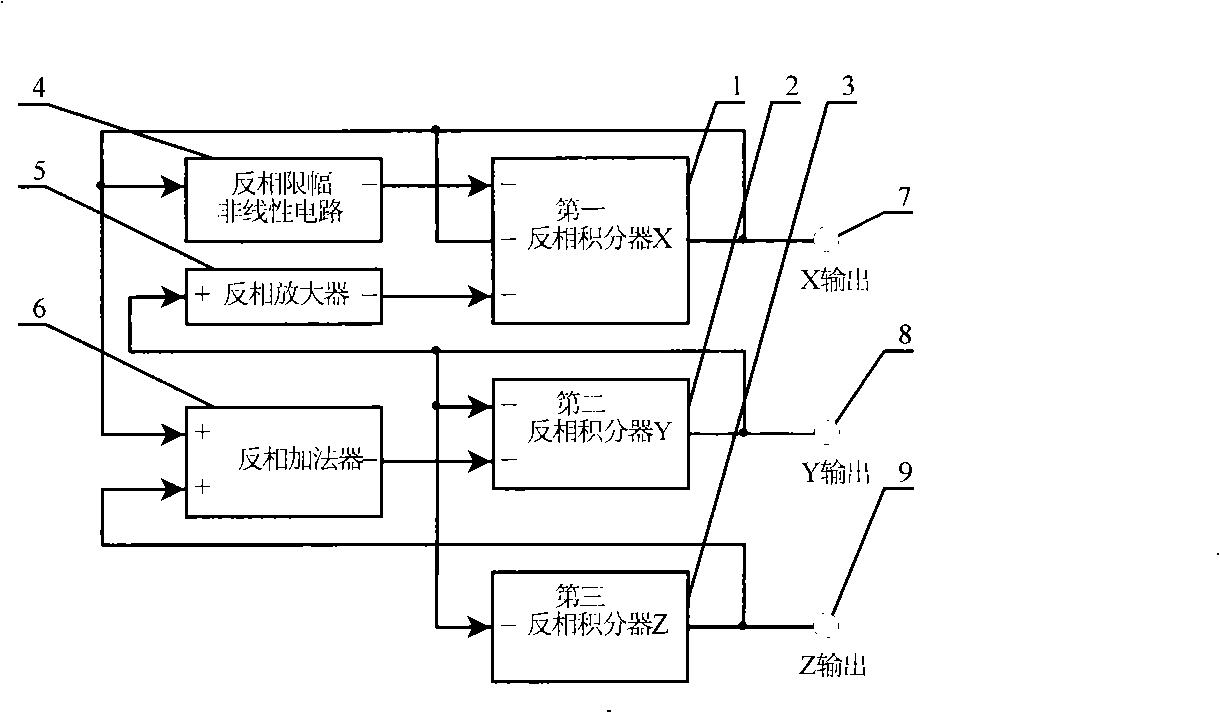Non-inductor Chua's circuit
A Chua's circuit, non-inductive technology, applied in the field of nonlinear circuits, can solve the problems of high cost, poor quality, and difficult debugging of chaotic application circuits, and achieve high stability and simple structure
- Summary
- Abstract
- Description
- Claims
- Application Information
AI Technical Summary
Problems solved by technology
Method used
Image
Examples
Embodiment 1
[0024] Such as figure 1 As shown, the non-inductor Chua's circuit provided by the present invention includes a first inverting integrator 1, a second inverting integrator 2, a third inverting integrator 3, an inverting limiting nonlinear circuit 4, an inverting amplifier 5 and Inverting adder 6, the output terminal X7 of the first inverting integrator 1 is respectively connected with an input end of itself, the input end of the inverting limiting nonlinear circuit 4, and an input end of the inverting adder 6; the second inverting The output terminal Y8 of the phase integrator 2 is connected with an input terminal of itself, the input terminal of the third inverting integrator 3, and the input terminal of the inverting amplifier 5; the output terminal Z9 of the third inverting integrator 3 is connected with the inverting addition An input terminal of the device 6 is connected; an output terminal of the inverse limiting nonlinear circuit 4 is connected with an input terminal of ...
Embodiment 2
[0060] Embodiment 2 is the first incompletely optimized non-inductor Chua's circuit of embodiment 1, see Figure 6 , the fifth resistor R in the fully optimized non-inductor Chua circuit 5 by the fourteenth resistor R 14 , the fifteenth resistance R 15 , the seventh operational amplifier U 7 , the sixteenth resistor R 16 to replace, where: the seventh operational amplifier U 7 The non-inverting input terminal is grounded, and the seventh operational amplifier U 7 The fifteenth resistor R is connected between the inverting input terminal and the output terminal 15 , the fourteenth resistor R 14 One end is connected with the seventh operational amplifier U 7 The inverting input terminal is connected, and the other terminal is connected to the first operational amplifier U 1 output connection, the sixteenth resistor R 16 One end is connected with the seventh operational amplifier U 7 The output end is connected, and the other end is connected with the second operational...
Embodiment 3
[0063] Embodiment 3 is the second not fully optimized circuit of Embodiment 1, see Figure 7 , the seventh resistor R in the fully optimized non-inductor Chua's circuit 7 by the fourteenth resistor R 14 , the fifteenth resistance R 15 , the seventh operational amplifier U 7 , the sixteenth resistor R 16 to replace, the seventh operational amplifier U 7 The non-inverting input terminal is grounded, and the fifteenth resistor R is connected between the inverting input terminal and the output terminal. 15 , the fourteenth resistor R 14 One end and the second operational amplifier U 2 The inverting input terminal is connected, and the other terminal is connected to the second operational amplifier U 2 output connection, the sixteenth resistor R 16 One end and the second operational amplifier U 2 The output end is connected, and the other end is connected with the second operational amplifier U 2 The inverting input terminal is connected; the rest of the circuit structure...
PUM
 Login to View More
Login to View More Abstract
Description
Claims
Application Information
 Login to View More
Login to View More - R&D
- Intellectual Property
- Life Sciences
- Materials
- Tech Scout
- Unparalleled Data Quality
- Higher Quality Content
- 60% Fewer Hallucinations
Browse by: Latest US Patents, China's latest patents, Technical Efficacy Thesaurus, Application Domain, Technology Topic, Popular Technical Reports.
© 2025 PatSnap. All rights reserved.Legal|Privacy policy|Modern Slavery Act Transparency Statement|Sitemap|About US| Contact US: help@patsnap.com



